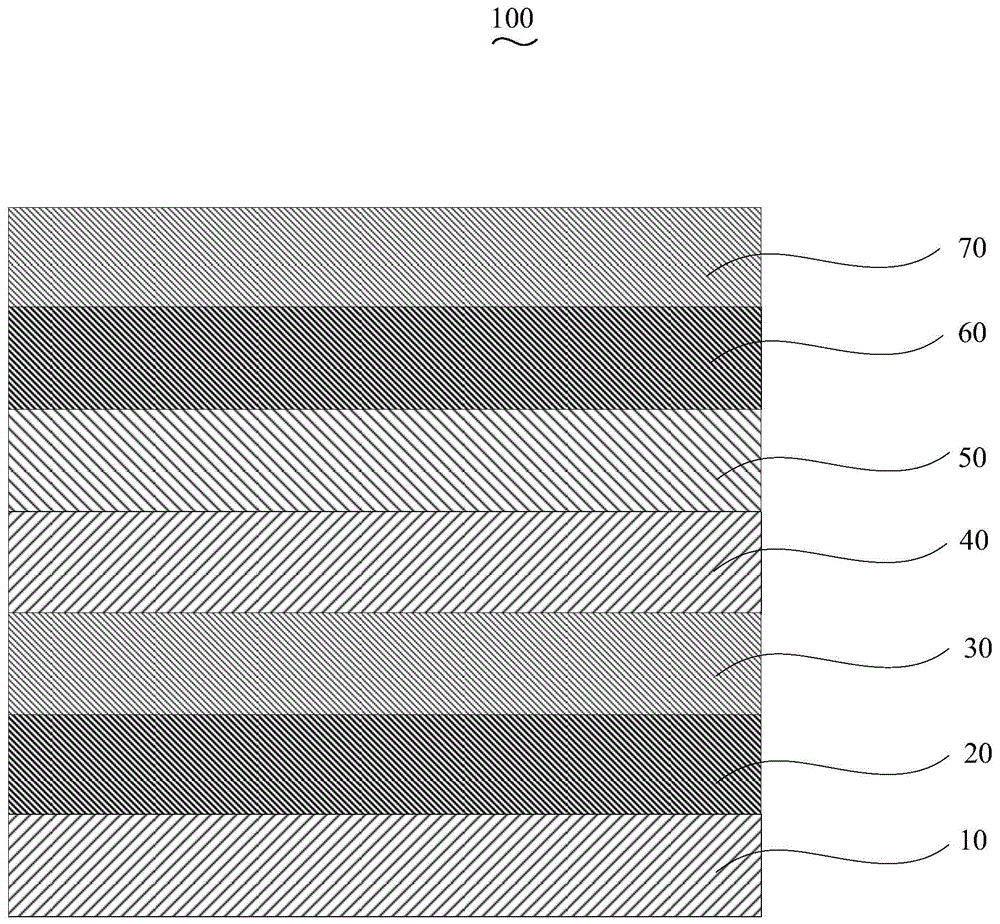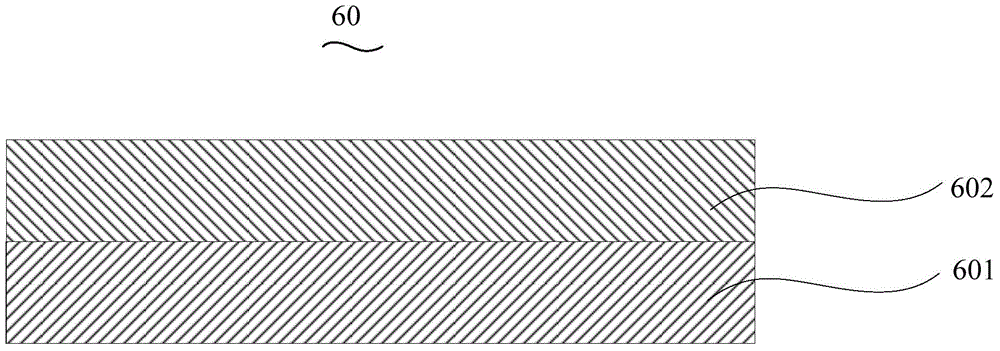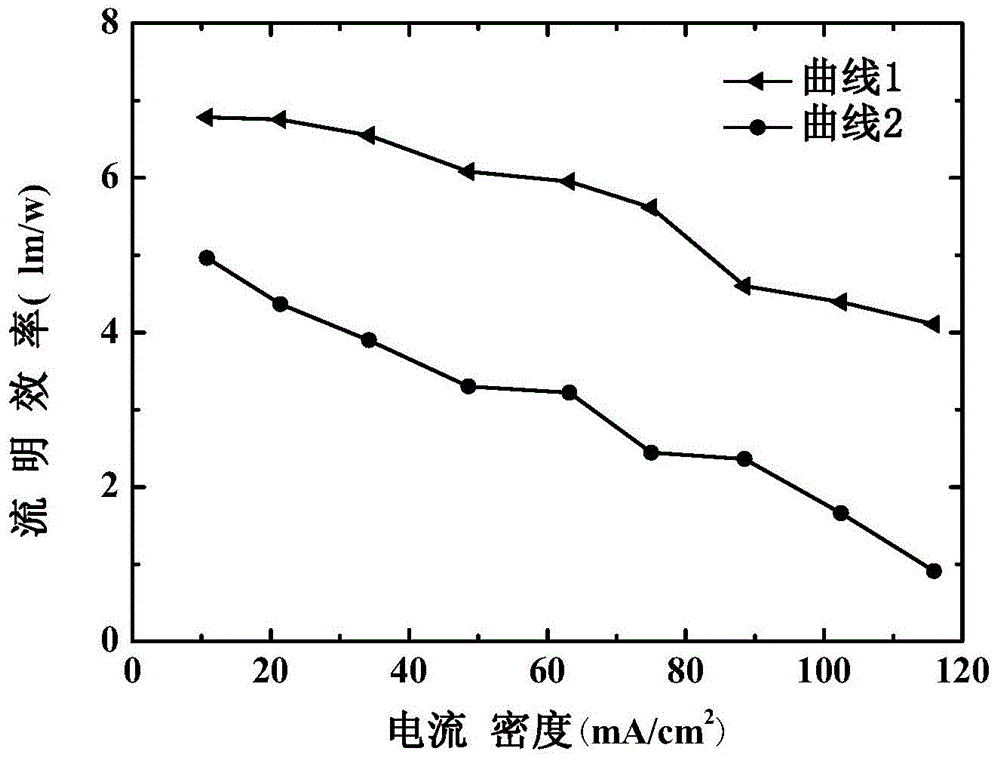Organic electroluminescent device and preparation method thereof
An electroluminescent device and a luminescent technology, which are applied in the fields of electric solid-state devices, semiconductor/solid-state device manufacturing, electrical components, etc., can solve organic functional layer damage, poor film-forming properties of lithium fluoride, and reduce the probability of electron and hole recombination And other issues
- Summary
- Abstract
- Description
- Claims
- Application Information
AI Technical Summary
Problems solved by technology
Method used
Image
Examples
preparation example Construction
[0034] The preparation method of the organic electroluminescence device 100 of an embodiment, it comprises the following steps:
[0035] Step S110 , sequentially forming a hole injection layer 20 , a hole transport layer 30 , a light emitting layer 40 , an electron transport layer 50 and an electron injection layer 60 on the surface of the anode 10 .
[0036] The anode 10 is indium tin oxide glass (ITO), fluorine-doped tin oxide glass (FTO), aluminum-doped zinc oxide glass (AZO) or indium-doped zinc oxide glass (IZO), preferably ITO, and the thickness of the anode 10 is 50 nm to 300 nm, preferably 145 nm.
[0037] In this embodiment, before the hole injection layer 20 is formed on the surface of the anode 10, the anode 10 is pretreated. The pretreatment includes: performing photolithography on the anode 10, cutting it into the required size, using detergent, deionized Water, acetone, ethanol, and isopropanone were each ultrasonically cleaned for 15 minutes to remove organic p...
Embodiment 1
[0052] The structure ITO / MoO prepared in this embodiment 3 / NPB / Alq 3 / Bphen / 2,6Dczppy:CsF / FeCl 3 / Ag organic electroluminescent device, in this embodiment and the following embodiments, " / " indicates a layer, and ":" indicates doping.
[0053] Magnetron sputtering anode on the glass substrate, the material is ITO, and then photolithography treatment, cut into the required size, followed by detergent, deionized water, acetone, ethanol, isopropanol ultrasonic 15min each, to remove the glass surface organic pollutants; after cleaning, conduct appropriate treatment on the conductive substrate: oxygen plasma treatment, the treatment time is 5min, the power is 30W; the thickness is 80nm, and the hole injection layer is evaporated, and the material is MoO 3 , with a thickness of 40nm; the vapor-deposited hole transport layer, the material is NPB, and the thickness is 30nm; the vapor-deposited light-emitting layer, the material is Alq 3 , thickness is 17nm; vapor deposition electr...
Embodiment 2
[0060] The structure prepared in this example is IZO / V 2 o 5 / TAPC / DCJTB / TPBi / TRZ4:CsCl / FeBr 3 / Pt organic electroluminescent devices.
[0061] Magnetron sputtering anode on the glass substrate, the material is IZO, and then photolithography treatment, cut into the required size, followed by detergent, deionized water, ultrasonic 15min, remove the organic pollutants on the glass surface; Hole injection layer: the material is V 2 o 5 , with a thickness of 40nm; evaporated hole transport layer: the material is TAPC, with a thickness of 45nm; evaporated luminescent layer: the selected material is DCJTB, with a thickness of 10nm; evaporated electron transport layer, the material is TPBi, with a thickness of 65nm; The injection layer includes a cesium salt doped layer and an iron salt layer, and the cesium salt doped layer is evaporated by thermal resistance, and the material is TRZ4:CsCl, the mass ratio of TRZ4 and CsCl is 5:1, and the thickness is 20nm; in the cesium salt Th...
PUM
| Property | Measurement | Unit |
|---|---|---|
| Thickness | aaaaa | aaaaa |
| Thickness | aaaaa | aaaaa |
| Power density | aaaaa | aaaaa |
Abstract
Description
Claims
Application Information
 Login to View More
Login to View More - R&D
- Intellectual Property
- Life Sciences
- Materials
- Tech Scout
- Unparalleled Data Quality
- Higher Quality Content
- 60% Fewer Hallucinations
Browse by: Latest US Patents, China's latest patents, Technical Efficacy Thesaurus, Application Domain, Technology Topic, Popular Technical Reports.
© 2025 PatSnap. All rights reserved.Legal|Privacy policy|Modern Slavery Act Transparency Statement|Sitemap|About US| Contact US: help@patsnap.com



